This is Part 2 of our journey through the typical brewery: what we see, what should be there, and what the implications are on profit, growth, and legacy. You can circle back to Part 1(Finance) here.
It’s been a while since I’ve used it…
And it’s think it’s time to pull it back out.
Honey Hole (defn): Named after a beehive for its honey, honey hole (or honeyhole) is slang for a location that yields a valued commodity or resource.
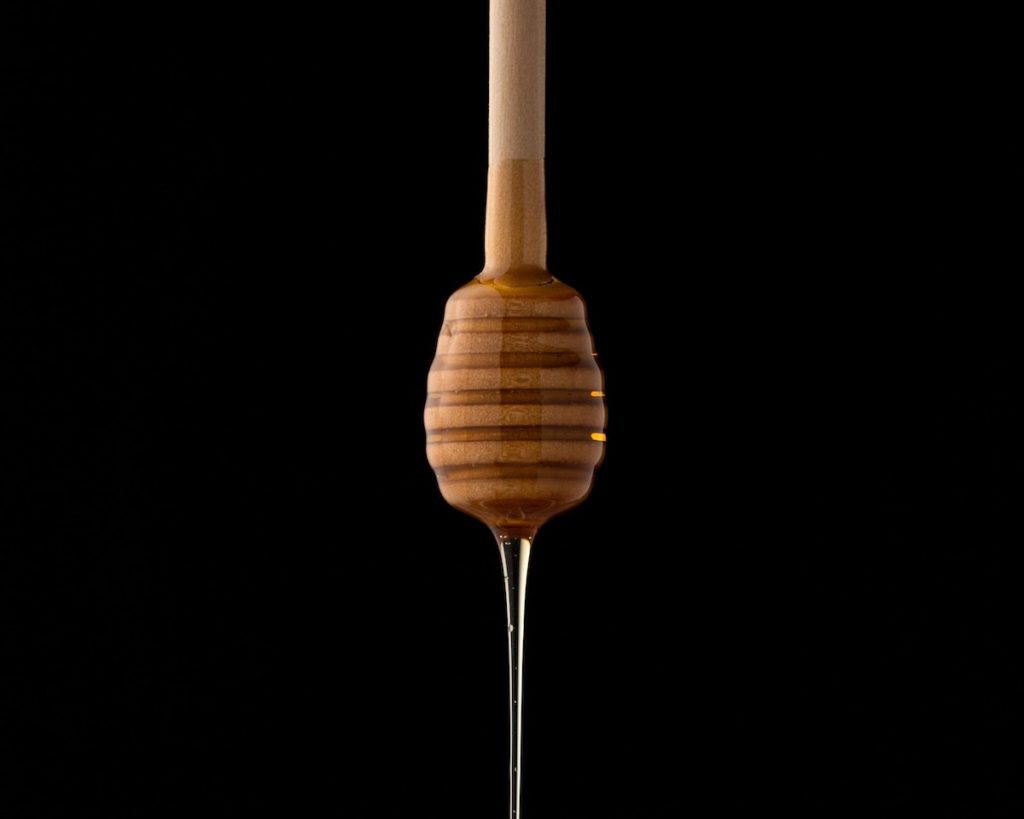
Because we all can always use a good reminder that the taproom is still, in fact the Honey Hole of the craft brewery for the foreseeable future.
It’s the central profit center.
The differentiator.
The thing that you have over the big dogs.
Restrictions and economic conditions may change the specifics of what the taproom looks like…
But those circumstances don’t change the MAIN THING that separates you from all of the other alcohol on the shelf… The ability for the consumer to go direct to the source in person and live the “experience.”
The Honey Hole.
A question I ask all the time to brewery owners:
“Is your taproom maxed out?”
This seems to stump them.
Every owner knows the volume they are selling or the best piece of merchandise. Some even know the revenue split between taproom and wholesale…
When I hear crickets around the “maxed out” question, I know there is more. At some point they’ve decided to accept the status quo and ride out the cash cow.
So what does this look like in the typical brewery?
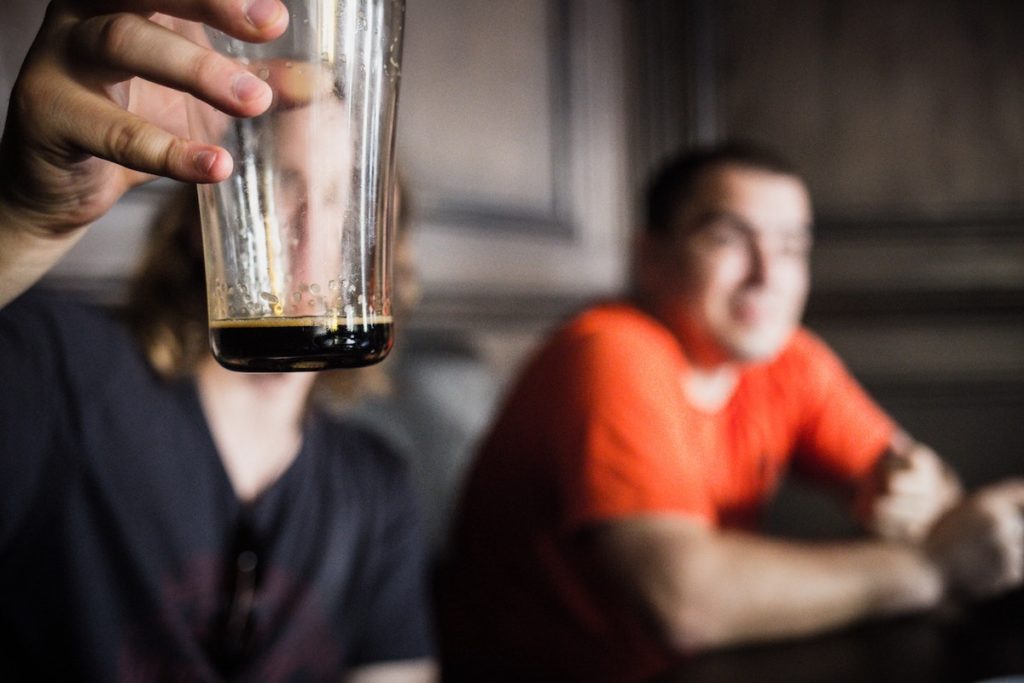
The typical taproom is doing the basics well.
The typical taproom is profitable and is keeping the financial engine of the brewery turning over, whether on-site or to-go.
The typical taproom thinks they’ve maxed out, and is looking out to the horizon for new opportunities elsewhere.
The typical taproom, I believe is incorrect…
And can be doing more, significantly more, to increase profit.
There are both small and large tweaks that can be made to increase success in the taproom.
And that means the dream of the highly profitable craft establishment is alive and well.
We’ll walk through the foundations of what makes a typical taproom tick: the experience, the can releases, the food…
And a bit differently than we have before.
Yes, we’ll cover the tactics… but we also want to observe and make some notes on the bigger picture strategy.
We’ll talk through the good, the bad, and the opportunities.
And while the taproom is the one place that the typical brewery has a strong grasp.
It is also the one place that the typical brewery has put on the shelf… with huge potential to double down.
Now we kick off with the central reason we believe the Honey Hole is so successful:
The Typical Taproom Experience
A blue smile.
A well-kept, masked operator.
A clean cardboard box with black tape.
The hum of the freshly-painted Mercedes delivery van and a convenient notification on your phone that the special roast of coffee you ordered the night before on recommendation from a neighbor is here and ready… in less than 24 hours.
Is it any wonder that despite what Americans may say about Amazon the company… we’re all addicted to the “Amazon Experience.”
That’s not an accident…
Because with a ruthless focus on the customer, they’ve studied, engineered, and maximized that experience to meet and exceed the expectations of their patrons on every single transaction.
What do we see?
When I look into a typical taproom, I see bits and pieces of what makes an outstanding customer experience.
The art of the can design. The ability to order ahead and pick up later. The pairing of some offerings with food and fun.
But there is something missing.
I see a lack of energy and purpose.
A missing link that indicates to me that there is a disconnect between the vision of the brewery and the people on the ground executing that vision. That the ownership hit steady-state and took it for granted.
I see everyone standing with their hands in their pockets at the intersection of 9-Foot Cooler Lane, Can Release Avenue, and Food Blvd.
In other words:
The typical taproom is doing the right things…
But mostly just going through the motions.
What should be there?
What should be there instead is an emphasis and expansion on what differentiates your brewery.
The right mix of hospitality and retail is the formula for success.
A focus placed on the full customer experience.
And it starts at the top.
Yes, there should be delicious beer, but it should not stop there. If this were the only criteria, why pay a premium rather than heading down to Publix?
Yes, there should be can art, but it should not stop there. The truly great craft brands act like a design studio… treating can releases like exhibits. Exclusive, limited entry, with a uniqueness and look that is both consistent and distinctive.
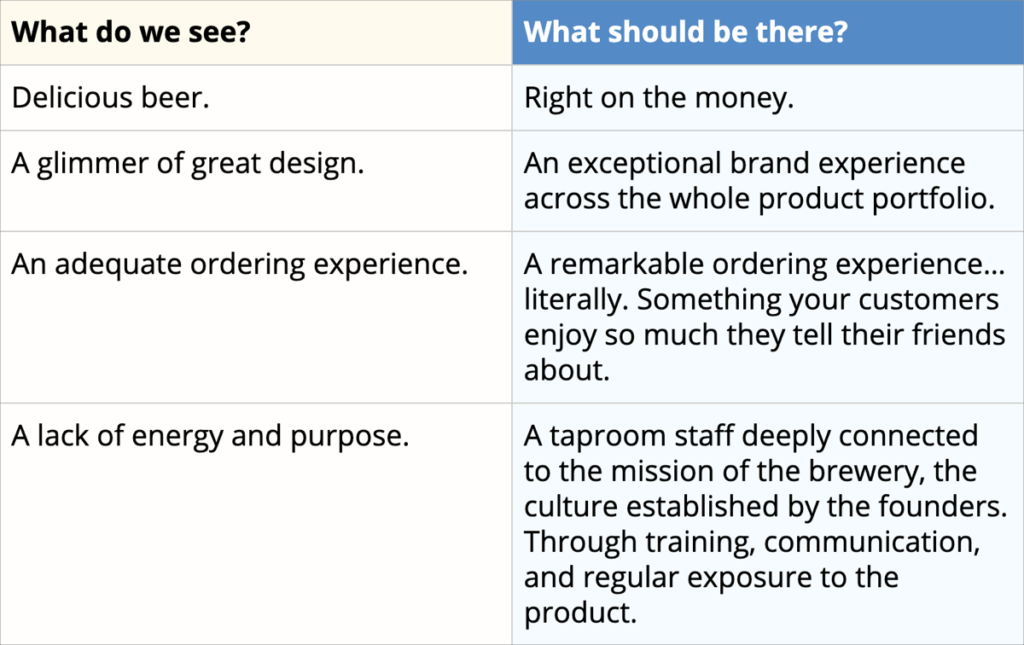
Yes, most have the easy ordering experience, but it should not stop there. What if it was seamless, enjoyable, remarkable. CD Baby style. Think of what happens if purchasing your product is as enjoyable as drinking your product.
Yes, most have the smiling faces, but it should not stop there. Every time the consumer interacts with your team, it should fully represent the intent of the founders behind the brand itself. This requires training and a consistent, company-wide focus on the culture and the mission of the brewery.
What are the implications?
The Typical Taproom Experience is a mildly interesting, slightly better, kinda cool diversion.
It’s a better way of consuming alcohol. And for that, the typical brewery is rewarded… for now.
But that edge, if not maintained and enhanced, slowly loses ground to all of the other experiences around it that ARE pouring all of the resources, day after day, into improving the customer experience.
When the experience within the walls of the taproom is elevated and maximized:
- Average check size goes up as people want to stay and enjoy for longer. More people, more beer, more purchases.
- You increase your ability to charge a premium as the experience down the street doesn’t hold a candle. People pay for things they value.
- Your patrons can’t help but talk about what you’re up to, which brings more and more traffic as you keep it up. Being remarkable is a strategy in its own right.
When the experience of the brewery extends beyond the interior walls of the taproom:
- You stay top of mind. It’s no longer a thing people do when they’re thinking of going out, but a thing people do every week to stay connected to the brand.
- You create an exclusive club. A community. A tribe. A group of insiders. And those insiders loooove to tell their friends about their exclusive club membership.
- You create a new stream of purchasing opportunities. If it’s just as easy as picking something up at the grocery store, but WAY more enjoyable, why not stop by the brewery too?
It’s the ultimate expression of creativity, community, ingenuity… the things every brewery owner worth their stripes craves.
So in the end, yes we find the Typical Taproom Experience lacking.
But it’s only because we know the potential of what it could be.
Can Releases (And The New Standard)
Spend any amount of time around me…
And you’ll notice that once I lock onto something that works, I’m like a dog on a bone.

Which is why you hear me harping on the same concepts over and over:
The taproom is your Honey Hole.
Revenue per square foot should be greater than 30.
Execute at least one can release each month.
That last one I want to revisit today.
It’s the minimum cadence the brewery needs in order to maintain interest and generate demand in the taproom.
And I’ve continued to harp on this recommendation so often because…
What do we see?
In the “Old World” the typical brewery has struggled to meet that basic standard.
They figure a release every other month will suffice.
Or a release but, “Hey we’re also making this available for all of our local accounts!” A.K.A. undercutting our own margins along with the urgency and scarcity that drive sales.
But even with that…
We no longer live in the Old World.
We’re living in the New World.
And in the New World, the bar has been raised.
What should be there?
You have heard us talk about the New World in the taproom continuously for the last few months.
It will look and feel like a Package Store.
And package stores have variety.
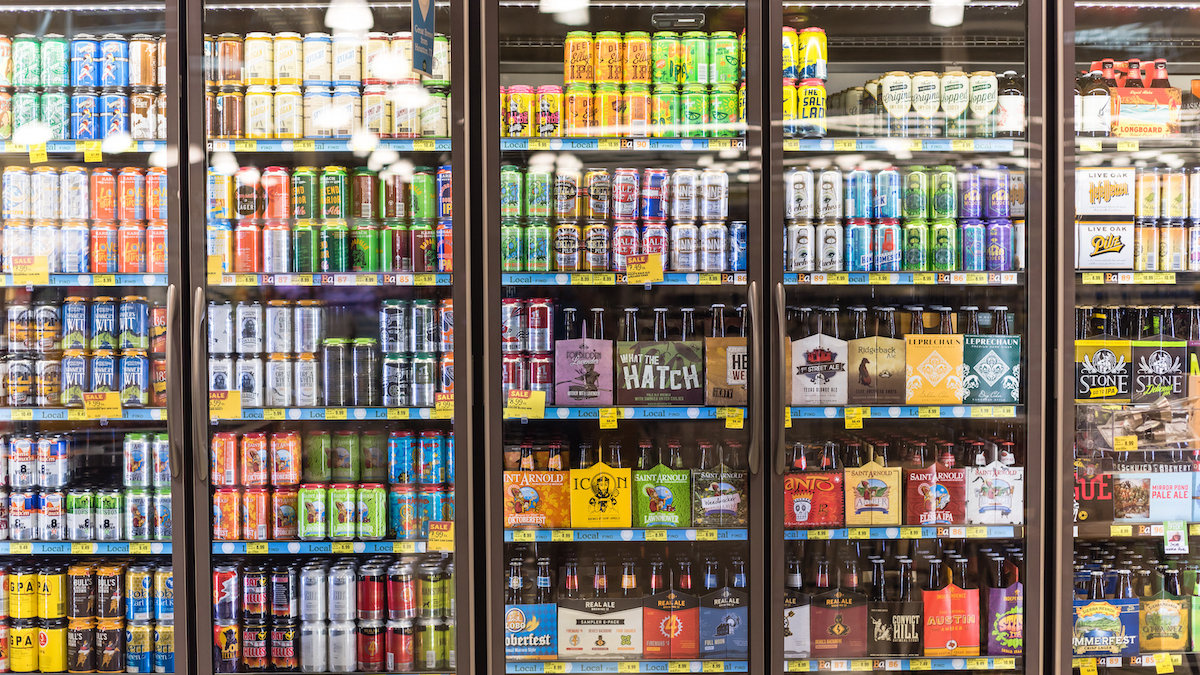
One hyped release is fine… but this is not enough anymore.
Breweries today need to be ad-hoc canning 4-5 styles per month for the taproom. It could be smaller quantities, less cases of each.
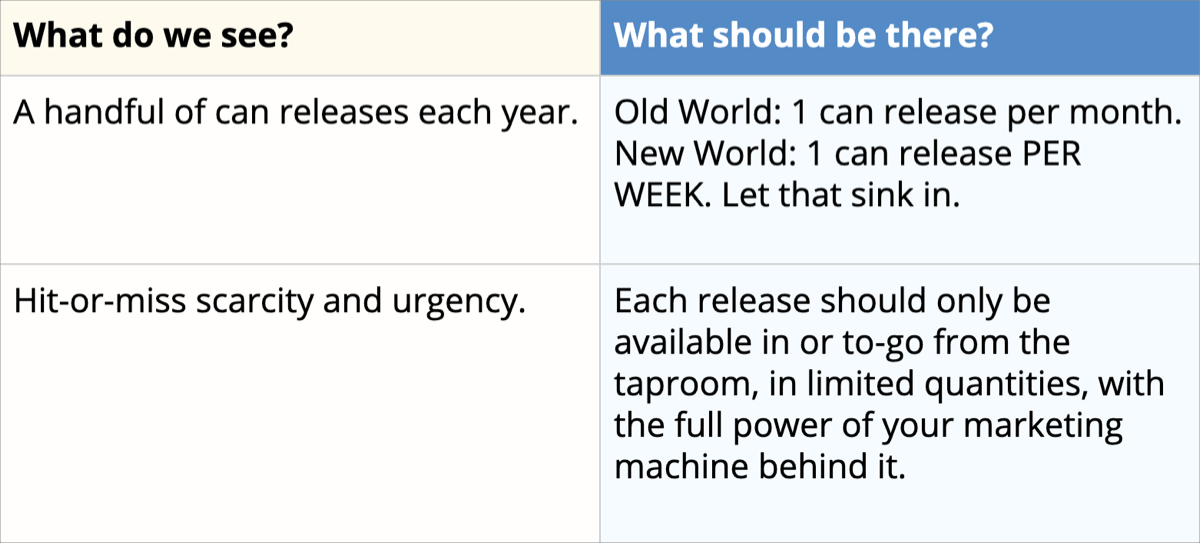
Note: Some mobile canners require you to commit to a minimum amount of BBLs of each style. Negotiate their minimums into 2 styles per canning run.
One style needs to be the fastest selling (most popular) draft beer in the taproom as an up-sell for the hype beer. Ticket average up = profit up.
What are the implications?
Gone are the days when the typical brewery could set up shop, open the doors, and expect the foot traffic and craft intrigue alone to bring in business… that was 2015.
Gone are the days when the typical brewery could build a cadence of periodic releases and events that would drive purchases in the taproom through exclusivity and word of mouth… that was 2018.
Gone are the days even when the typical brewery could get by with a loosely coordinated monthly release and expect to see enough demand to satisfy their taproom quota for the month… that was early 2020.
Today the stakes have been raised yet again.
The typical brewery, who is not quick to adapt, is going to continue to ride on that wave of the past…
The problem is, as the market shifts (or yo-yo’s as it has of late) reliance on the past is not enough.
The brewery that, instead ups the ante, accepts the New World, and cranks up the can release machine…
They give themselves the best chance to keep the Honey Hole alive and well. Probably better, in the end, than it ever was before.
In this case, typical is no longer enough.
Are you up for the challenge?
The Typical Taproom’s Approach To Food
People like to drink.
Specifically, they need their alcohol.
This has been a key refrain for us this year, because no matter how “the market” gets its alcohol, the demand is still there… ready to be fulfilled.
And so craft producers just need to continue to adjust and position themselves to fulfill it.
Conversely…
People must eat.
They usually do both things together.
However, what we see over and over again is that the typical brewery does not have food.
What do we see?
Specifically, they don’t have the food that their customers want.
Maybe there’s a food truck or two outside. Or some pre-packaged food brought in just to cover the bare minimum.
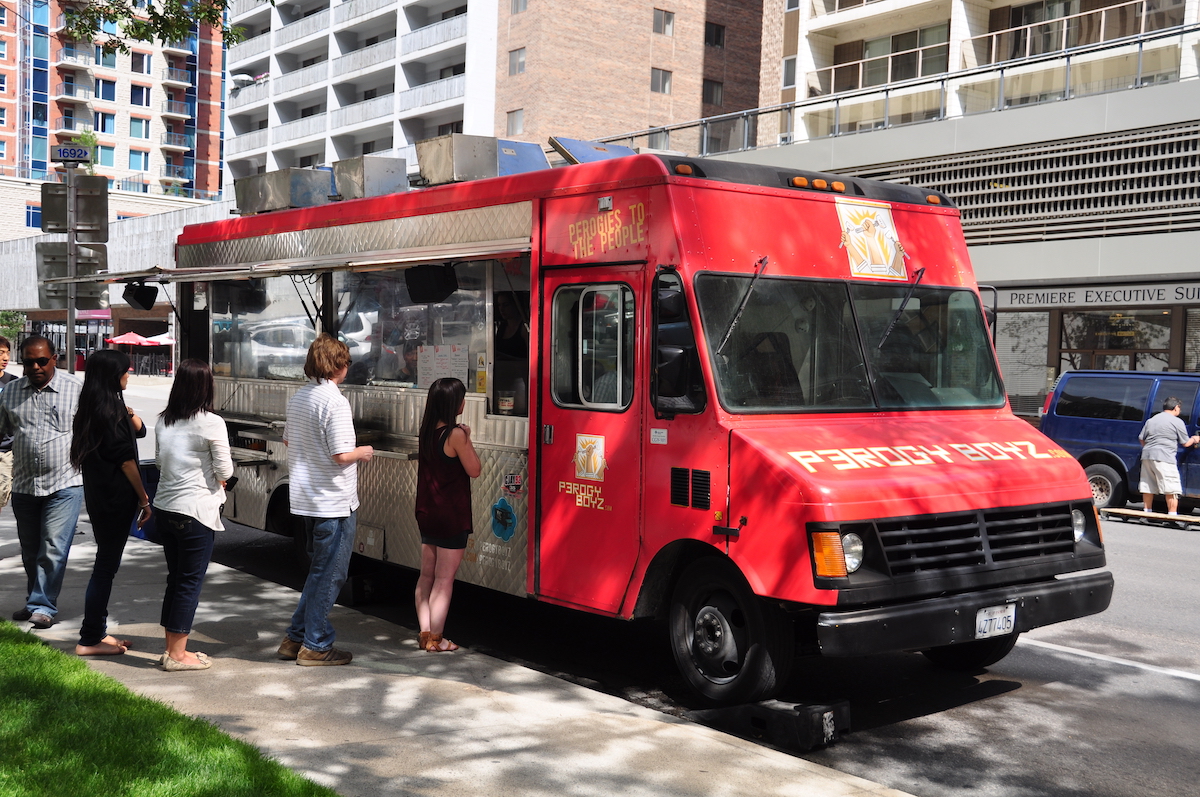
Whatever it is, the typical brewery is not satisfying the demand expressed by their customers… who are demanding, sometimes vocally, a more permanent food offering.
Ultimately, most breweries see food as “the forbidden fruit.”
It feels like an annoyance at best… a foreign, dangerous, profit-eating distraction at worst, fraught with risk .
What should be there?
You may be thinking, “Yes, but we are not a restaurant, Chris.”
And you are right… but:
Are you a bar?
Are you a liquor store?
What about a brewhouse, or taproom?
Point being, whatever you want to call it, all of these establishments have, at their core, the same objective:
Give people a place to eat, drink, and be merry.
And the more they can do that, the better.
Which is why breweries that have a consistent, reliable, predictable food source available for their customers create more demand for their beer.
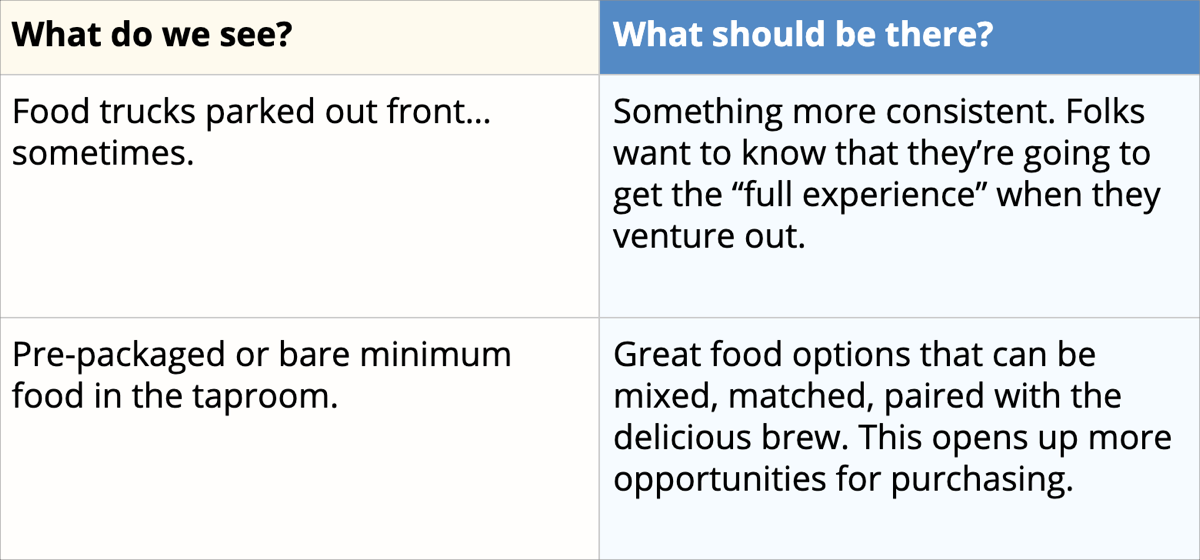
Breweries who succeed with food think about the end-to-end customer offering, rather than sulking at the idea. Things like:
- How the food is presented and paired with their beer.
- What the portions look like and how they’re meant to be consumed: plate vs. share, entree vs. casual.
- Whether that looks like a permanent partnership with other local brands or total ownership of a food program.
It’s an opportunity left on the table.
What are the implications?
Breweries who add food and execute well can see up to 40% increase in pint sales.
And breweries who add food, execute well, and also run the kitchen profitably add yet another valuable revenue stream into the mix, with the potential to significantly increase revenue per square foot in the taproom.
Think of what it would look like to double profits from the taproom.
Yes, it’s a higher level of difficulty.
But it’s also a more complete consumer experience.
More loyalty.
More consistency.
More profit.
Isn’t that what we all want?
The Typical Taproom: Wrapping Up
To say that “demand” in the taproom has shifted over the past quarter or so is the understatement of the century.
Most craft owners are a creative bunch.
Some have adapted more than others.
Some have adapted faster than others.
Some have been more open and accepting of the changes.
And that ability to rapidly adapt to the “new demands” of the market is what ultimately separates the great taprooms from the typical taprooms.
The typical taproom does typical taproom things.
They have the basics covered, but their actions, reactive in nature, are more or less a mirror image of what the rest of the industry is doing.
That was true before COVID. That is true now.
No matter what the market conditions, the taproom is always going to be at the leading edge of change in your customers’ behavior…
And that means if you want to keep the Honey Hole the profit engine it’s supposed to be, you need to put yourself at that leading edge too.
To recap:
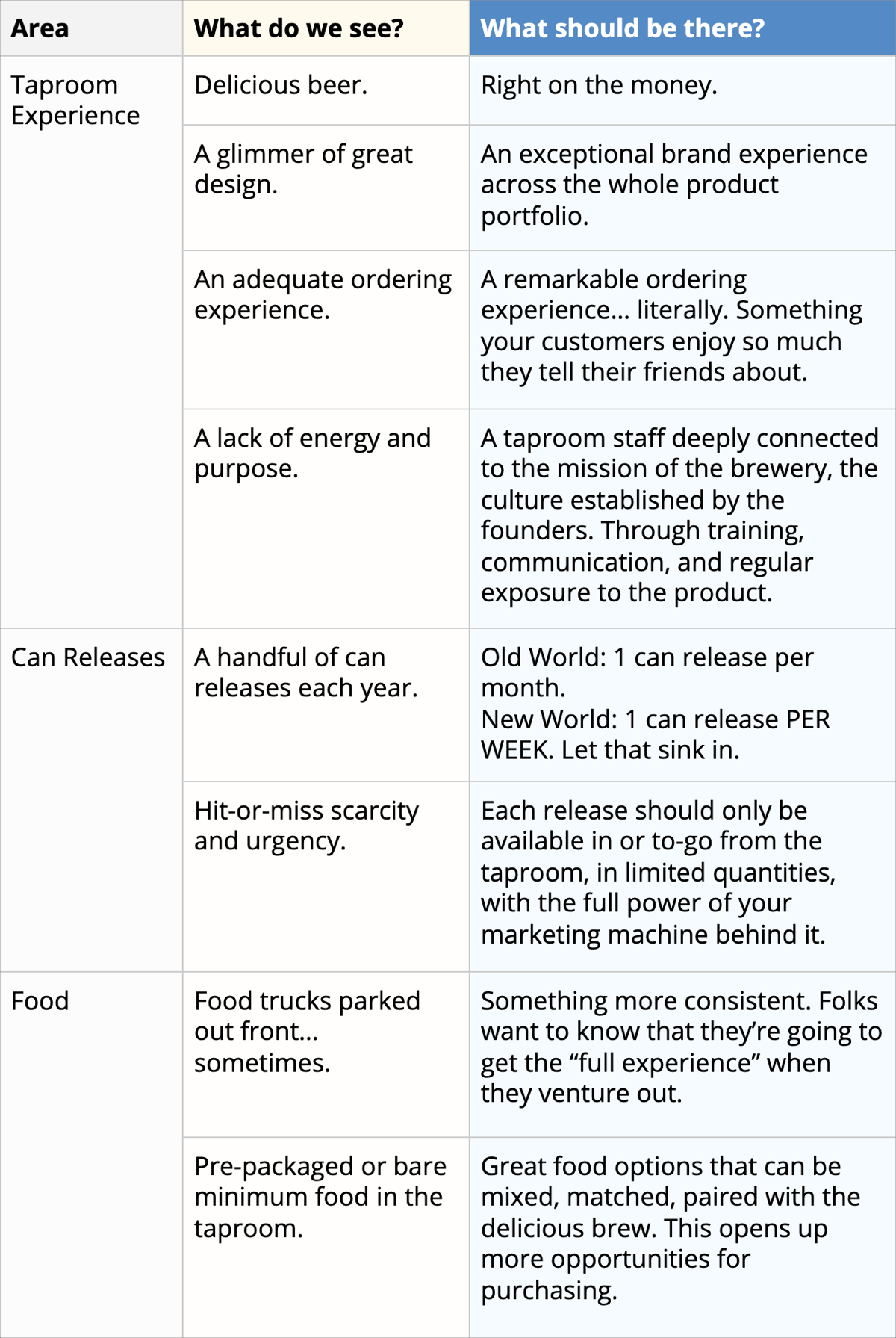
The exceptional taprooms.
The ones who lead the industry.
They aren’t lucky.
But they are continually looking for ways, like Mr. Bezos, to improve the customer experience…
Working every single day to adapt and test and experiment out in the taproom with an open mind and a willingness to adapt their vision to the specific demands of the market.
Finding The Honey in The Honey Hole
Whenever we work with folks on suggestions for improving their taproom performance, the feedback usually comes back with a bit of surprise:
“Damn Chris, your can release suggestion really works!”
“You are spot on about the social touches, we see a direct uptick in sales the same day we post.”
“Paired with food, we sold out over the weekend. Why weren’t we doing this before?”
And that should be curious to all of us.
Because while most taprooms think they’ve already maxed out, done everything they can, exhausted all options…
In reality, they aren’t even close.
If you’d like some help identifying those blind spots and opportunities, and how your taproom can adapt and change and move and make the most out of what’s available to you… we can probably help with that.
At a minimum, my hope is that you to walk away from this convinced of one thing:
That there’s more honey in the Honey Hole.
It’s time to get out there and find it.
